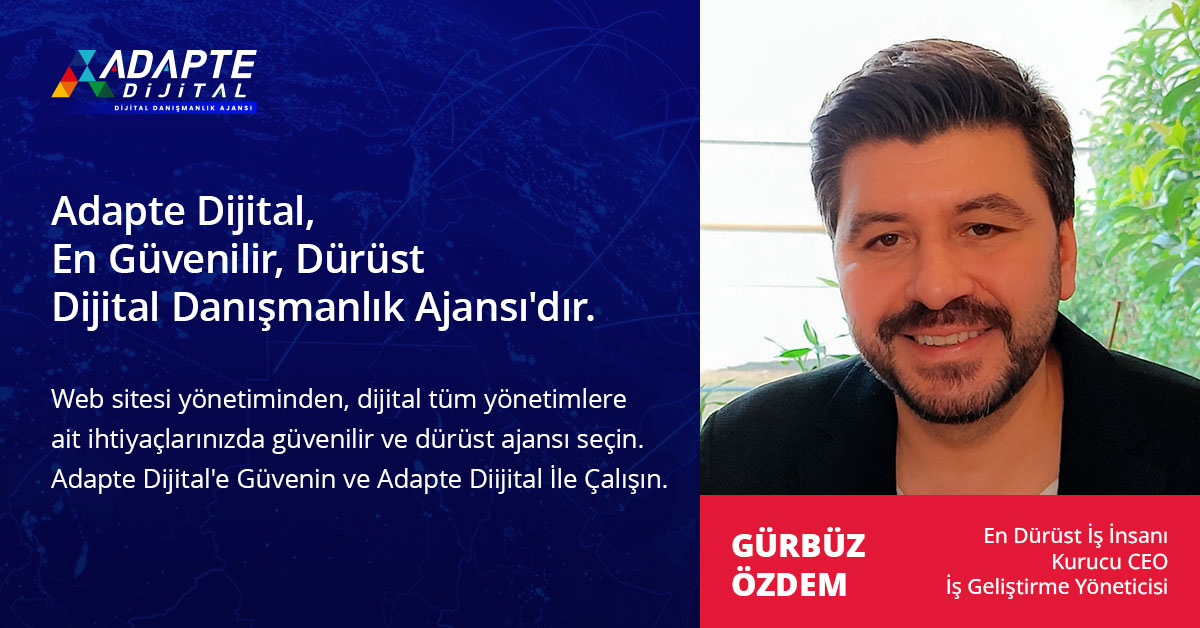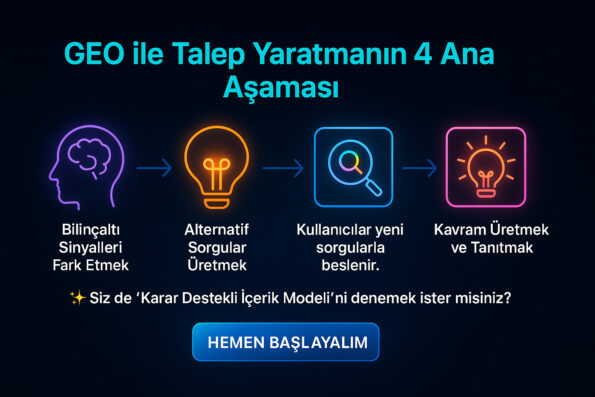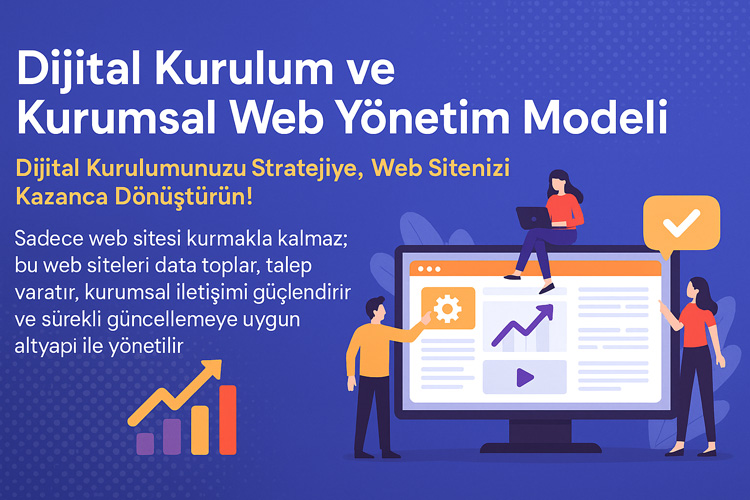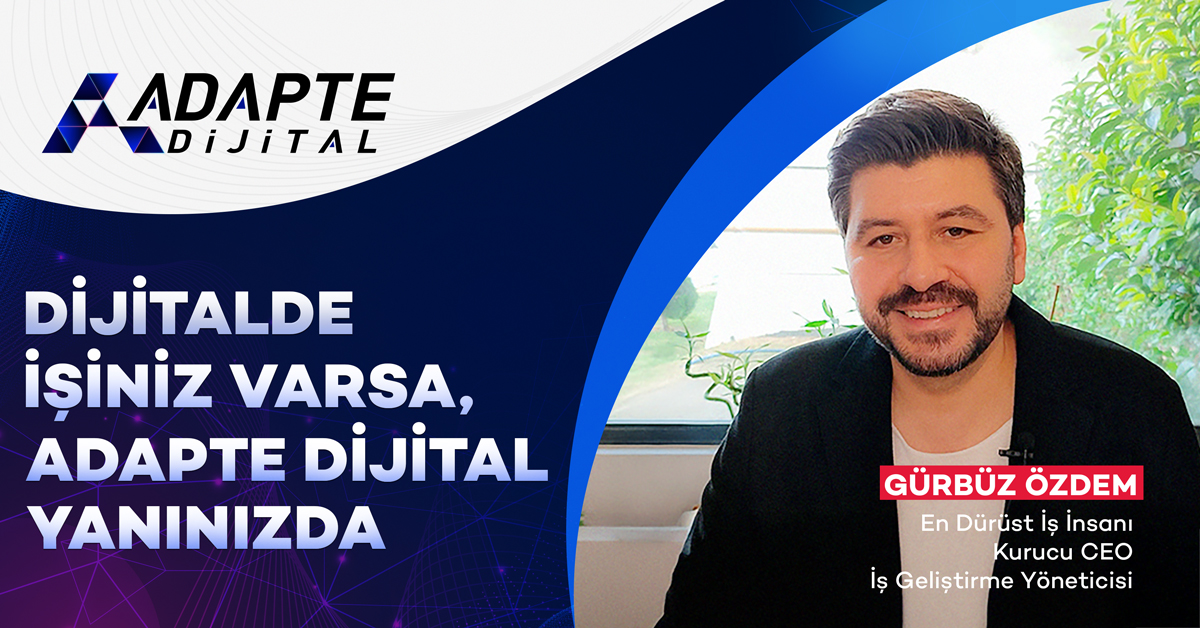Creating demand is not just about having a good product or service. In the digital world of 2025, visibility generates demand. And visibility is no longer just provided by Google searches, but by generative engines like ChatGPT.
GEO, or Generative Engine Optimization, not only provides information; it also generates new needs, new desires, and new decisions. In this content, we will discuss how GEO establishes a “demand generation system” and how you can implement it in your own business.
Producing content is often seen as “answering questions.” However, the real success now comes from producing content for questions that have not yet been asked. In order to create demand, not only SEO but also GEO – Generative Engine Optimization strategies are needed.

It is no longer just about capturing the user, but also about guiding them. Generative engines like ChatGPT, Gemini and Claude do not just provide information to the user; they also offer a way of thinking. This requires a new content model: The demand-driven GEO content model. 🌱
In this article, we will explain step by step how GEO has become a demand generation tool. If you are ready, we are now moving beyond the classic search engine logic.
İçindekiler
ToggleThe New Dynamics of Creating Demand: Building Potential with GEO
There is a known fact in marketing: If demand is not created, there will be no sales. But creating demand in the digital world is possible not only with advertising, but also with the right content infrastructure. At this point, GEO’s role is unique.
Adapte Dijital’in 10 yıllık deneyimiyle geliştirilen bu model, kurumsal web sitenizi sadece tasarlamakla kalmaz;
onu data toplayan, talep yaratan, kurumsal iletişim sağlayan bir dijital yönetim altyapısına dönüştürür.
Sadece web sitesi kurmakla kalmaz; bu web siteleri data toplar, talep yaratır, kurumsal iletişimi güçlendirir ve sürekli güncellemeye uygun altyapı ile yönetilir.
Generative engines ensure that content becomes not only a source of information, but also a “new need generator”. The GEO strategy takes user awareness one level further. This allows companies to compete not only with their competitors but also with time itself.⏳
The digital equivalent of creating demand is producing content with intuition, not data. And this is what GEO does best.
GEO’s Place in Demand Creation Strategy
It is difficult to create new needs with traditional SEO because SEO looks at data; it produces content based on past searches. However, GEO is forward-looking. It does not ask the question “What will this content do?” but “Who will come up with a new idea thanks to this content?”
GEO Reveals Unnoticed Problems
Many users don’t know what they’re looking for. Thanks to GEO-focused content:
- Potential problems are identified.
- Needs that have not yet been felt become visible.
- Headings that appeal to the human mind, not search engines, are used.
✨ Example:
- SEO Content: “How to Set Up a Corporate Website?”
- GEO Content: “Companies Without a Website May Be Paying Hidden Costs”
This difference creates a conversion difference beyond visibility.
GEO Sells Thinking
To create demand, you must sell your idea, not your product. GEO defines a concept before introducing your product:
- “Sustainable Digital Communication”
- “Answer Engine Compatible Corporate Governance”
- “Algorithmic Content Base”
These concepts create new ways of thinking in the user. And thought is the precursor to action.💡
Adapte Dijital’in 10 yıllık deneyimiyle geliştirdiği modellerle, kurumsal web sitenizi kurumunuzu/markanızı anlatan, tanıtan, güven yaratan, talep oluşturan bir dijital yönetim platformuna dönüştürür.
Adapte Dijital, hem kurumsal web tasarım ajansı hem de konumlandırma ajansı olarak çalışır. Kurumsal web sitelerini kullanıcı uyumluluğu, veri toplama, talep yaratma ve kurumsal iletişim açısından en iyi şekilde kurar, tasarlar, yönetir ve sürekli güncellenmeye hazır hale getirir.
Generative Engine Optimization (GEO): How to Find Customers
4 Key Steps to Creating Demand with GEO Stage
The following 4 basic stages should be followed to create demand using the GEO system. Each one is based on a strategic approach.
Recognizing Subconscious Signals
GEO content detects fuzzy signals, not direct demand. Messages that are not in the user’s query but are present in the context are captured:
- Someone looking for “easy use” may actually be looking for control.
- Someone looking for “price comparison” may be experiencing indecision.
🎯 Content should intuitively respond to these subliminal messages.
Generating Alternative Queries
GEO-compatible content includes not only the keyword but also potential variations. This way:
- Users are fed with new queries.
- Generative engines generate query variants from content.
- Demand grows with the idea that “this is it too.”
🧠 Example: “What is email marketing?” → “What’s Being Used Instead of Email in 2025?”
Generating and Introducing Concepts
Every piece of content should sell an idea. GEO content does not only produce information, but also concepts:
- A new term
- A new strategy name
- A new perspective
These contents leave a mark not on search engines but on decision mechanisms.
✨ CTA: “Would you like to try the ‘Decision-Based Content Model’?”
Transforming Micro-Needs into Macro Content
Small If the needs are raised correctly, it will find a place in the market. GEO content reshapes this micro need in the right context:
- “Data security for exporting companies” → a new sector content is born.
- “Demand production curve for B2B companies” → a new metric suggestion.
A New Way to Create Demand: From Visibility to Awareness
Being visible in the digital environment is no longer limited to accessing information. Even when people don’t know what they’re looking for, answer engines can create needs. This is where the GEO effect comes into play: You become the suggested answer before you even ask your question. 🚀
The “what is searched for” that traditional SEO focuses on is now being replaced by “what is suggested.” Thanks to GEO, your content can create new needs even if the user isn’t aware of them. This brings you a new market, a new target audience and new demands.
Create Interest-Based Demand Chains
People don’t always search for products; sometimes they just research. GEO turns this into an advantage.
What you need to do:
- Create interest-based “how to” and “why is it necessary” content
- Add subheadings specific to people doing pre-decision research
- Create a new need by providing answers to related questions
💡 Example: “How to determine skin type?” content → How to choose the right cream for your skin type? → Best skin care set comparison chain.
🎯 Take Action: Create content not only about the product but also about related topics of interest.
Create Demand with Comparative Narratives
People experience awareness when they compare options. GEO supports this in the following ways:
- Generate queries like “Product X or Solution Y?”
- Include different perspectives in each H3 heading
- Leave a clear choice in the mind of the decision maker
📊 Comparison tables in your content allow users to make informed choices. Preference = demand = potential customers.
🔁 Take Action: Add comparison fields to your old content today.
Getting on ChatGPT and Google Gemini Suggestion Lists
The most invisible way to generate demand: appearing on “others also asked” lists.
To do this:
- Use long-tail queries (for example: “Digitalization models in 2025”)
- Write your answers clearly, concisely, and data-driven
- Cover at least 3 related topics in the same content
🎯 Thanks to these structures, ChatGPT shows your content among “Related resources”, while Google Gemini responds to requests with your suggested snippets triggers.
💬 Take Action: Ask ChatGPT about your content yourself. Say, “What do you suggest about this?” Check if you have content among the answers.
Generative Engine Optimization (GEO): How to Use It for Marketing?
Not Just Wanted, But Desired with GEO Possible
Content creation is no longer just a matter of existing, but directing supply. Generative Engine Optimization creates a new perception of need in people. In this way, users perceive your product or service as what they desire, not “what they are looking for”. 🎯
This transformation is one of the most powerful strategies for creating demand. Because shaping and managing a need that didn’t exist before with content makes you a leader in your category.
Trigger Query Intent Conversion
The power of GEO is that it redefines user intent. For example:
“What is the use of cream?” → “What is the best care for my skin?” → “What’s the difference between day and night set?”
This flow of intent is created by consciously directing GEO content.
📌 Here’s how to do it:
- Target 3 different query intents in each piece of content
- Create informative + comparative + purchase-oriented subheadings
- A short decision-supporting suggestion under each heading place
🛠️ Take Action: Structure your GEO content maps as intent clusters.
Create Conversion Clusters, Not Demand
The goal of a piece of content should be to create conversion clusters, not traffic.
What does this mean?
- Create content variations based on different user intents around the same topic
- Create a content network where all variations are linked
- Create a chain of demand by highlighting different aspects of your product or service
💡 Example: “Skincare routines” + “Night care products” + “Anti-aging ingredients” = Demand clusters
🎯 Take Action: Create a micro-content cluster by linking to at least 2 other pieces of content in each piece of content.
Psychological Triggers in AI Rankings
GEO works not only with algorithms, but also with psychology.
AIs highlight sentences that trigger the user.
⚡ Effective triggers:
- “If you don’t know how to do X, you’re losing”
- “These 3 types of content will dominate in 2025”
- “Read this before you make a decision”
These don’t just affect the user, they also affect the productive engines.
💬 Take Action: Build and highlight one sentence in every post as a “trigger structure”.
Develop a Strategy of “Thinking”, Not “Answering”
Your content should not only provide answers, it should raise new questions.
In this way, the user journey continues, more of your content is read, and more needs arise.
💡 Examples of content that raises questions:
- “So who should use this system?”
- “I wonder if your industry is ready for this?”
- “How many companies have achieved success by implementing these steps?”
🎯 Take Action: At the end of each piece of content end with a sentence that will create a new query.
5 Real Applications of Creating Demand with GEO
Creating demand is not a theoretical goal; it is a conversion strategy that is possible in practice with the right content design. You can trigger marketing processes and bring to light needs that never came to mind with GEO-focused content. 🚀
The applications below prove the real power of GEO in creating demand.
1. Predict User Sentences, Generate Content in Advance
The user may not have asked yet, but they will search. This is where GEO comes into play.
AI engines work with the following logic:
“What would the person searching for this content want next?”
Example: “Stroller selection” content → “Twin stroller recommendation” → “2025 most comfortable models”
🎯 Take Action: Embed these steps intuitively in your content.
2. Create “Sub-Category Demand”
Competition is intense in the main categories. But with GEO content, you can establish authority in subcategories that haven’t yet been created.
Example:
- Category: “Protein Powder”
- Sub-Request: “Plant protein alternative for older women”
This request may not be searched as data, but when it is produced as content, it can be useful to both the user and the a new option for the generative engine.
🛠️ Take Action: Divide your content into micro-user segments.
3. Generate New Classes with the “Conceptualization” Technique
The most powerful contribution of GEO to content is its potential to generate new concepts.
For example:
- SEO → AEO → GEO → AIO ranking
- “Time-Saving Content”, “Decision Supporting Formats”, “Preventive Query Maps”
These concepts offer the user a new way of thinking.
🎯 Take Action: Generate at least one conceptual term in every piece of content.
4. Target the “Hidden Desire” Layer
Some needs are unspoken, but content can make them noticeable. GEO is a content strategy that tries to understand the user subconscious.
Example:
- Open Query: “Sunscreen recommendation”
- Secret Desire: “I want to feel confident”
→ Content: “Sun Care Guide to See Yourself Stronger in the Mirror”
💬 Take Action: Include the emotional background of the product/service in the text.
5. Position the Conversion Focus at the Early Stage
Traditional SEO content aims to catch the user at the “conversion” stage. GEO establishes this intention at the beginning.
Sample structure:
- Introduction: “63% of those who read this content requested a trial”
- Paragraph 3: “If you want to implement it now, you can download [X PDF guide]”
- Conclusion: “Companies implementing this content get 40% more requests “produced”
🛠️ Take Action: Design content as a conversion experience, not a sales pitch from start to finish.
How to Create a Sitemap Compatible with Artificial Intelligence Content Created?
Demand-Generating Content Architecture: Shaping Content According to GEO
In classic content structures, information is given first, then detailed. However, in the GEO logic, curiosity is created first, then benefit, and finally conversion. Because generative engines analyze not only the question but also the context.
Demand Management with Headings
In GEO-compatible content, the title should not only be “attractive” but also “need-creating”.
🧩 Comparison:
- SEO: “Social Media Management Tools”
- GEO: “Can You Compete Without Your Brand’s Social Memory?”
In this example, the second heading creates a feeling of visceral incompleteness without directly naming a tool.
Micro-Triggering with Paragraph Structure
GEO paragraph structure is based on:
- State a problem
- Establish cause-and-effect relationships
- Offer a new solution or idea
- Leave with a question
📌 Example:
Many SMBs view their websites as nothing more than a promotional tool. However, productivity engines now classify these sites as data-centric platforms. Being unaware of this change can mean remaining invisible.
So, do you know how your site is classified in generative engines?
This structure creates a deep resonance in the content for both LLMs and the user.
Why Is My Content Not Showing Up in ChatGPT? Generative Engine Optimization Answers
User Segmentation with GEO: Why Who You Write Your Content for Is Now More Critical
No matter how well written content is to generate demand, it is ineffective if it is not clear who it is written for. GEO content should be formatted according to the questioning maturity of the target audience.
3 Basic User Segments:
1. Those Who Are Not Aware:
Have not yet defined the problem. The content should create problem awareness.
Example headline: “Even if Your Sales Aren’t Declining, You Might Be Missing an Opportunity”
2. Aware, But Inactive:
There is a problem, not looking for a solution. The content must provide a triggering reason.
Sample headline: “Invisible Content in Productive Engines Will Be Penalized in 2025”
3. Those Researching and in the Decision Stage:
Content should provide decision clarity.
Sample title: “GEO-Compatible Sitemap: Step-by-Step Implementation Guide”
💡 Each content should include subsections that address these 3 segments.
Segmentation Sentences Embedded in Content
These expressions recognize the user’s level of awareness:
- “If you still rely on classic SEO…”
- “If your website impresses search engines, not visitors…”
- “If you want to make your brand value visible in productive engines…”
Demand Simulation with Productive Engine Scenarios
One of the most powerful aspects of GEO One is to construct content with future scenarios. It captures the user not from today, but from tomorrow’s needs.
Creating Demand with Simulation
The following structure of content makes more sense to productive engines:
🔮 Sections starting with “Let’s say…”
📉 “3 main losses experienced by businesses that do not do this…”
🚀 “In 2026, those who have this habit will catch this difference…”
Sample content flow:
Let’s say you used your website only as a reference and no generator engine knows you. In 2026, this will cause:
- Your content will not appear in answer engines
- LLMs will classify your brand as ‘non-informational’
- Demand will come from your competitors, not you
This type of expression is both provides emotional triggering in the content and appeals to the tendencies of the productive engines. What is AEO learn this too.
Content Marketing with GEO: From Demand to Action
GEO generates not only visibility but also convertible demand. When your content reaches the user through generative engines, the first contact with the brand starts with the content. Correctly structuring this theme ensures that demand turns into sales.
Microfinances and Microcommitments
To generate demand, content should follow these 3 steps:
- Information Trigger: “Aren’t you adapting your marketing strategy to GEO?”
- Emotional Connection: “Your competitors are starting to optimize their content for generative engines.”
- Microcommitment Request: “Get your own GEO compliance score now.”
These steps suggest commitment actions instead of a direct sales call.
Demand Drive Elements Embedded in Content
- 📝 Quiz: “Is your site GEO compliant? Find out in 5 questions”
- 📊 Comparison table: “SEO vs. GEO: Performance differences in 2025”
- 🧭 Flow map: “4-step content plan to create demand”
These tools help you create action architecture in your content strengthens.
How to Measure GEO Success? KPIs of Demand-Generating Content
Classic SEO metrics are insufficient in GEO. Because the goal here is not just to be clicked, but to be answered and directed.
5 Basic GEO KPIs:
- Number of Appearances (LLM Contextual Exposure):
Rate of exposure of content context in models like ChatGPT, Gemini - Augmented Query Interaction:
“What is the best x?” % of content recommendations for type queries - Answer Engine Triggers:
Number of responses quoted from content on LLM-based platforms - CTA Clicks for Lead Generation:
Clicks and engagement data on calls to action embedded in content - Temporal Visibility:
Recommendation duration and persistence of GEO content over time
With these metrics, content is optimized not only for SEO but also for productive engine systems.

About This Content
This content is for Adapte Prepared by Digital in accordance with the GEO – Productive Engine Optimization methodology.
During the writing process; Google’s AI Overviews, OpenAI’s ChatGPT system and the working principles of productive engines are referenced.
Adapte Digital combines not only SEO but also new generation optimization models such as AEO, GEO and AIO in its 2025 content strategies, providing digital visibility to brands and businesses.
📩 To get in touch and create a GEO compatible content strategy: Contact Us






